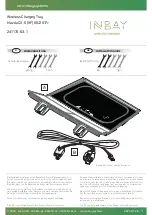
For example, if you check and fill
your tires in a warm area, then drive
in extremely cold weather, the tire
pressure will be lower than
measured and could be underinflated
and cause the low tire pressure/
TPMS indicator to come on. Or, if
you check and adjust your tire
pressure in cooler conditions, and
drive into extremely hot conditions,
the tires may become overinflated.
However, the low tire pressure/
TPMS indicator will not come on if
the tires are overinflated.
Refer to page
for tire inflation
guidelines.
Although your tire pressure is
monitored, you must manually check
the tire pressures monthly.
Each tire, including the spare, should
be checked monthly when the
vehicle is cold, and set to the
recommended inflation pressure as
specified on the vehicle placard and
in the owner’s manual (see page
).
If there is a problem with the TPMS,
you will see the above message on
the multi-information display.
If you see this message, the system
is off and is not monitoring the tire
pressures. Have the system checked
by your dealer as soon as possible.
If there is a problem with the TPMS,
this indicator begins to flash. It stops
flashing after approximately 1
minute, then stays on. You will also
see a ‘‘CHECK TPMS SYSTEM’’
message on the multi-information
display (see TPMS System Failure).
390
389
TPMS System Failure
Tire Pressure Monitoring System (TPMS)
342
10/09/02 14:25:11 31TM8610_347
Summary of Contents for 2011 Insight
Page 6: ...10 09 02 13 41 36 31TM8610_005 ...
Page 64: ...U S models Canadian models Safety Labels 58 DOORJAMBS 10 09 02 13 49 13 31TM8610_063 ...
Page 354: ...348 10 09 02 14 25 46 31TM8610_353 ...
Page 404: ...398 10 09 02 14 32 01 31TM8610_403 ...
Page 450: ...444 10 09 02 14 37 37 31TM8610_449 ...
















































